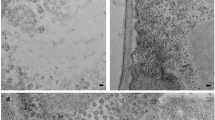Summary
Turnip protoplasts infected with cauliflower mosaic virus (CaMV) have been used to examine the kinetics of CaMV DNA synthesis, and the different classes of CaMV DNA found in vivo partially characterised. Differential extraction techniques for DNA from infected protoplasts has identified several distinct classes of viral DNA. The same approach applied to virus preparations revealed that while the majority of virion DNA was stably encapsidated, some small DNAs and a heterogeneous population 3.8-ca. 5.0 Kb were not. The structural relationship of sa-DNA (3) with the particle is such that only its 5′ RNA moeity is susceptible to nuclease attack. Two-dimensional gel electrophoresis of total CaMV DNA from infected protoplasts revealed all the DNA species found in virion DNA, those species representing the ‘free’ DNA class and a further class of molecules, rich in DNA of (−) polarity (24), to which the role of reverse transcription intermediates has been ascribed. ‘Free’ DNA contains 8 Kb supercoiled DNA (Form I DNA), an 8 Kb open circle (Form II), an 8 Kb linear (Form III) and a truncated molecule with an extension of the (−) strand previously observed from infected plants (10). Kinetic experiments show that the accumulation of total CaMV-DNA parallels the accumulation of progeny virions to reach a maximum around 72 h post-inoculation and that there is not a separation of CaMV-DNA synthesis into clearly defined early and late stages.
Similar content being viewed by others
References
Chen ISY, Temin HM: Ribonucleotides in unintegrated linear spleen necrosis virus DNA. J Virol 33:1058–1073, 1980.
Covey SN, Grierson D: Subcellular distribution and properties of poly(A)-containing RNA from cultured plant cells. Eur J Biochem 63:599–606, 1976.
Covey SN, Turner D, Mulder G: A small DNA molecule containing covalently linked ribonucleotides from the large intergenic region of the cauliflower mosaic virus genome. Nucleic Acids Res 11:251–264, 1983.
Favaloro JM, Triesman RH, Kamen RI: Transcriptional maps of polyoma virus-specific RNA: Analysis by two-dimensional S1 gel mapping. Methods Enzymol 65:718–749, 1980.
Furusawa I, Yamoaka N, Okuno T, Yamamoto M, Kohno M, Kunoh H: Infection of turnip protoplasts with cauliflower mosaic virus. J Gen Virol 48:431–435, 1980.
Guilfoyle T, Olszewski N, Hagen G, Kuzj A, McClure B: Transcription and replication of the cauliflower mosaic virus genome: Studies with isolated nuclei, nuclear lysates, and extranuclear cell-free leaf extracts. In: Plant Molecular Biology UCLA Symposium (Goldberg R, ed), Alan R Liss, New York, 1983, pp 117–136.
Guilley H, Richards KE, Jonard G: Observations concerning the discontinuities of cauliflower mosaic virus. EMBO J 2:277–282, 1983.
Hull R, Covey SN: Does cauliflower mosaic virus replicate by reverse transcription? Trends Biochem Sci 8:119–121, 1983.
Hull R, Covey SN: Replication of cauliflower mosaic virus DNA. Sci Prog Oxf 68:403–422, 1983.
Hull R, Covey SN: Characterisation of cauliflower mosaic virus DNA forms isolated from infected turnip leaves. Nucleic Acids Res 11:1881–1895, 1983.
Hull R, Shepherd RJ, Harvey JD: Cauliflower mosaic virus: An improved purification procedure and some properties of the virus particles. J Gen Virol 31:93–100, 1976.
Kao KN, Michayluk MR: Nutritional requirements for growth of Vicia hajastana cells and protoplasts at very low population density in liquid media. Planta 126:105–110, 1975.
Marco Y, Howell SH: Intracellular forms of viral DNA consistent with a model for reverse transcriptional replication of cauliflower mosaic virus genome. Nucleic Acids Res 12:1517–1528, 1984.
Maule AJ: Infection of protoplasts from several Brassica species with cauliflower mosaic virus following inoculation using polyethylene glycol. J Gen Virol 64:2655–2660, 1983.
Maule AJ, Hull R, Donson J: The application of spot hybridisation to the detection of DNA and RNA viruses in plant tissues. J Virol Methods 6:215–224, 1983.
Miller RH, Tran C-T, Robinson WS: Hepatitis B particles of plasma and liver contain viral DNA-RNA hybrid molecules. Virology 139:53–63, 1984.
Mount DW: Modeling RNA structure. Bio/Technology, Sept.: 791–795, 1984.
Olszewski N, Guilfoyle T: Nuclei purified from cauliflower mosaic virus-infected turnip leaves contain subgenomic, covalently closed circular cauliflower mosaic virus DNAs. Nucleic Acids Res 11:8961–9014, 1983.
Olszewski N, Hagen G, Guilfoyle TJ: A transcriptionally active, covalently closed minichromosome of cauliflower mosaic virus DNA isolated from infected turnip. Cell 29:395–402, 1982.
Pfeiffer P, Hohn T: Involvement of reverse transcription in the replication of the plant virus CaMV; a detailed model and test of some aspects. Cell 33:781–789, 1983.
Pfeiffer P, Laquel P, Hohn T: Cauliflower mosaic virus replication complexes: characterisation of the associated enzymes and the polarity of the DNA synthesised in vitro. Plant Molec Biol 3:261–270, 1984.
Shepherd RJ, Wakeman RJ: Observation on the size and morphology of cauliflower mosaic virus deoxyribonucleic acid. Phytopathol. 61:188–193, 1971.
Southern EM: Detection of specific sequences among DNA fragments separated by gel electrophoresis. J Mol Biol 98:503–517, 1975.
Thomas CM, Hull R, Bryant JA, Maule AJ: Isolation of a fraction from cauliflower mosaic virus-infected protoplasts which is active in the synthesis of (+) and (−) strand viral DNA and reverse transcription of primed RNA templates. Nucleic Acids Res. Submitted for publication, 1985.
Turner DS, Covey SN: A putative primer for the replication of cauliflower mosaic virus by reverse transcription is virion-associated. FEBS Lett 165:285–289, 1984.
Volovitch M, Modjtahedi N, Yot P, Brun G: RNA-dependent DNA polymerase activity in cauliflower mosaic virus-infected leaves. EMBO J 3:309–314, 1984.
Yamaoka N, Morita T, Furusawa I, Yamamoto M: Effect of temperature on the multiplication of cauliflower mosaic virus. J Gen Virol 61:283–287, 1982.
Author information
Authors and Affiliations
Rights and permissions
About this article
Cite this article
Maule, A.J. Partial characterisation of different classes of viral DNA, and kinetics of DNA synthesis in turnip protoplasts infected with cauliflower mosaic virus. Plant Mol Biol 5, 25–34 (1985). https://doi.org/10.1007/BF00017870
Received:
Revised:
Accepted:
Issue Date:
DOI: https://doi.org/10.1007/BF00017870




